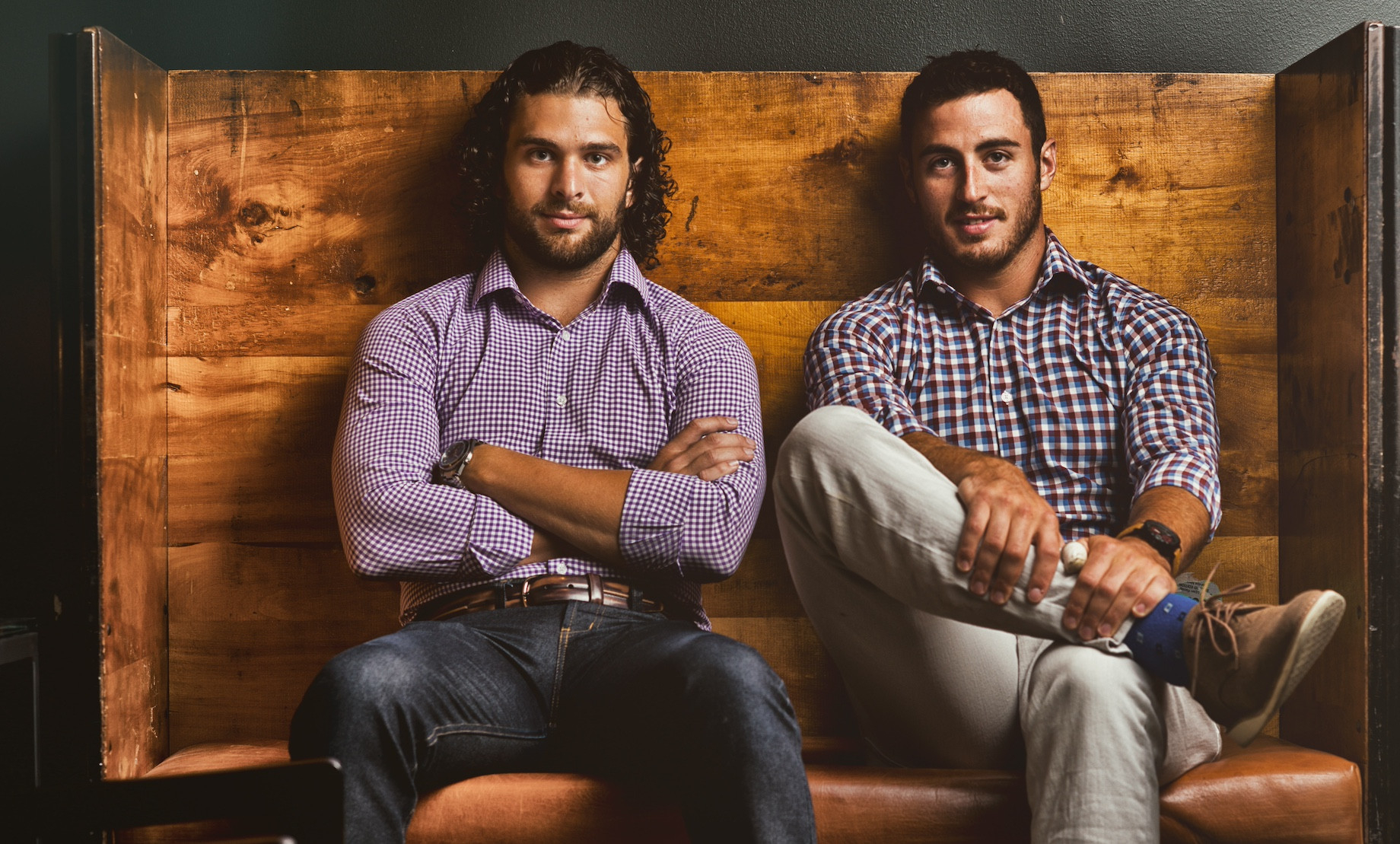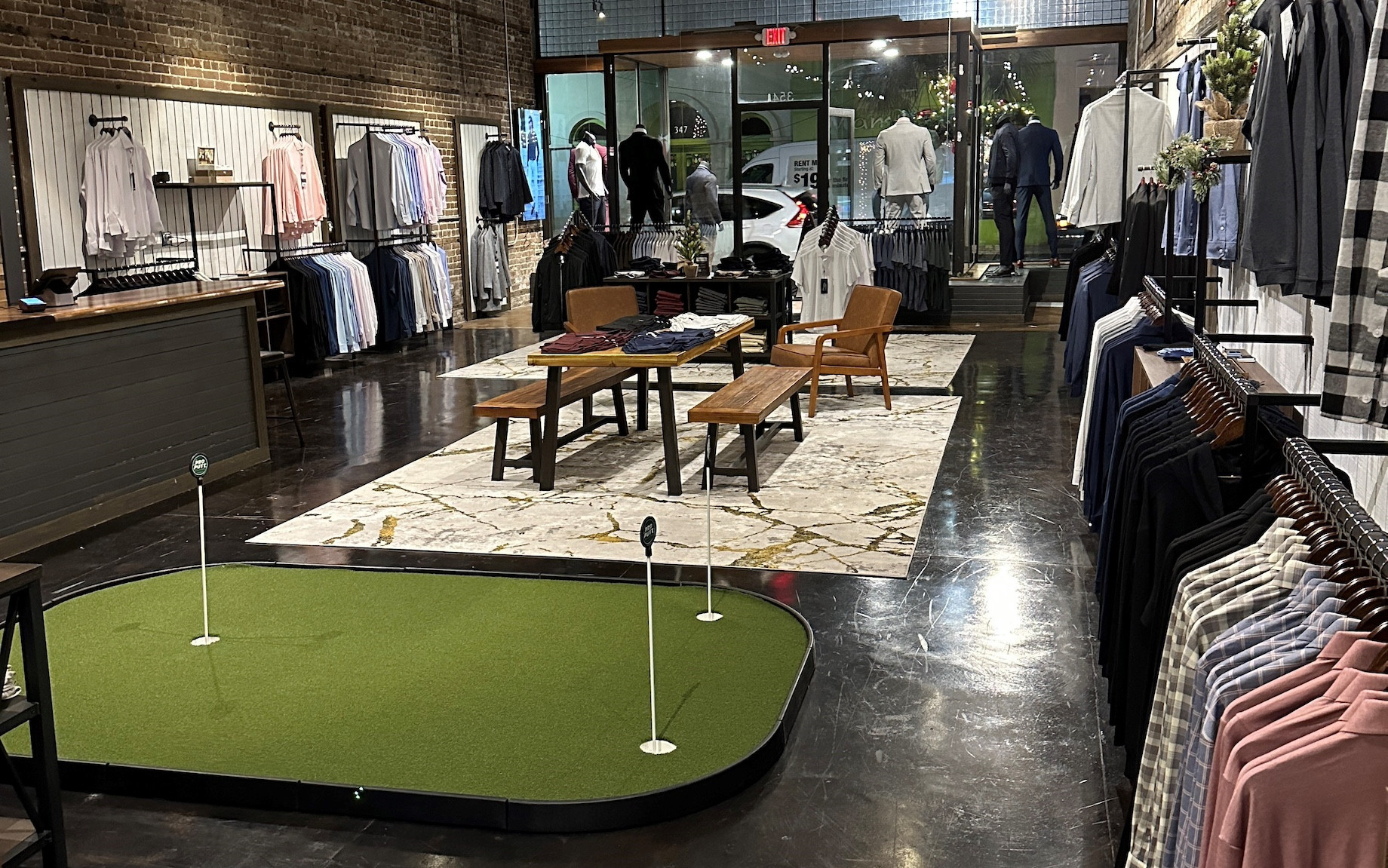State & Liberty started because of an ill-fitting dress shirt — or rather, many of them. “We hated every dress shirt we’d ever worn,” said Steven Fisher, who co-founded the men’s clothing retailer with fellow University of Michigan graduate Lee Moffie.
In 2013, the recent graduates were annoyed that they couldn’t find any well-fitting shirts for their builds. Fisher said. “We wanted something that was bigger in the shoulders, chest and arms and tapered at the waist for the athletic guy.” They also wanted it made from the same moisture-wicking, wrinkle material that you could find in a workout shirt, but they didn’t want it to look like a shirt you’d wear at the gym. “We wanted something that had a true professional look so you could wear it to the office or a wedding and no one would know the difference between that and a traditional cotton dress shirt,” he said.
With no fashion experience — “Lee was a professional hockey player. I was a math major,” Fisher said — they created a product line themselves. What gave them the confidence to go forward? “Naivete,” he laughed. They created samples, and friends seemed to really like them. “We put a couple on sale, sold those and got some good feedback,” Fisher said.
Today State & Liberty — named for the Ann Arbor, Michigan, intersection where the two met — boasts 26 retail locations, including La Jolla, California; Washington, D.C.’s Georgetown; New York City; and Kansas City, Missouri. The offerings include not just dress shirts but products from overcoats to four-way-stretch tuxedos.
Fisher talked to ICSC Small Business Center contributing editor Rebecca Meiser about how the brand transitioned from e-commerce to also include brick-and-mortar, the strategic use of pop-ups and more.

Steven Fisher, left, and Lee Moffie
How did you find the materials, factory and designer for your product line?
I’d taken a school trip overseas in college and had had a couple of custom suits made. When we decided to start the company, I reached out to the person who had made those and was like: “Hey, if we send you some fabric that’s different than what you’ve used before, could you make us a couple of custom shirts?” She said absolutely. Afterward, we went online and started researching factories and went all over the place finding fabric samples. We were in my parents’ basement, getting just thousands of little swatches shipped to us that we were feeling and pulling on and stretching. We found a couple we liked and had them shipped to her. I’d say the first samples were not up to par with what we’re looking for, but it got us on the right track to the point that we knew there was something there.
What was the hardest part in the beginning?
It was all hard. The product we first launched — we would be embarrassed to have that on sale today. It took us a long time to figure out the fit, but a lot of iteration and a lot of feedback from customers and friends got us to a point where we were happy. For the first six months or so, we were both still working. Lee was still playing pro hockey. After that, I quit my job and Lee retired from his pro hockey career — well, he called it retiring; I called it quitting — and we decided to give it a go. Lee and I put in about $3,000 each to buy that first run of shirts. Since then, it’s just been all cash flow of selling shirts, taking the profits and reinvesting it back into the company.
How did you know you were onto something?
When we started getting emails from people letting us know that this is what they’d been looking for their whole life. For the first year-and-a-half, it was just dress shirts. There was nothing else. Then we came out with some polos and then overcoats, which we never thought would be the next product for us but we found some great fabric, we made some samples and people loved it.
“Especially for a product like ours, where the fit and the fabric are so important, to actually be in front of somebody and have them try it on and feel it makes a world of difference.”
Who is your demographic?
Early on, we thought our demographic was 23 to 30, guys right out of school and at an office every day. But there are guys who are in shape and also want athletic-fit stuff across all age ranges, so we run the full age range now from 25-year-olds to 85-year-olds.
You started as an e-commerce company in January 2015. Was opening brick-and-mortar locations your plan all along?
We started out thinking we would be an e-commerce company only, but then somebody convinced us to do a pop-up in Boston. We spent 10 days on Newbury Street. It was a fantastic retail spot. It was the summer of 2017, when retail wasn’t doing as well as it is now, so [landlords] were much more amenable to a 10-day pop-up. It went extremely well, and after that, we sort of fell in love with brick-and-mortar. Especially for a product like ours, where the fit and the fabric are so important, to actually be in front of somebody and have them try it on and feel it makes a world of difference.
How did you figure out where to have pop-ups? How did leasing managers respond to you?
Early on, nobody really wanted to work with us. We would walk along the streets and take numbers off the door and call those places and say: “Hey, would you rent us your space?” We’re more sophisticated now, working with more brokers, but at the time, it was just us doing it. Now, we’ve expanded into some lifestyle centers, but for the first two to three years, it was all urban street retail. We felt that that was where our customer was. We also felt it was more of a place where people would be looking to find a new brand. Whether Newbury Street or Nolita or Georgetown or Lincoln Park, people are walking around looking for cool things to check out.
How did you decide to expand to permanent locations?
Through our pop-up locations. We would do a couple months at a time, prove that [our concept] would work and then sign extensions. That’s how it was for really quite some time. I think the biggest investment we did was a two-month pop-up in September and October of 2018 in New York City. It went really well. We extended for two months and then another year, and now we’re still in the same spot in Nolita five years later.

State & Liberty’s Charleston, South Carolina, store opened just before Christmas.
How did you decide to connect with SRS Real Estate Partners for help with your real estate search?
Carter [D’Auria, first vice president of SRS] originally reached out. She had heard about our store in Washington, D.C. At the time, we were open to anybody that could bring us great real estate. We’d had challenges with a master broker-type relationship, but SRS brought expertise and market info from all over the country. We were looking to expand pretty aggressively in new cities and places and needed somebody to help us manage that expansion process. They’ve been super helpful in getting us in front of landlords across the country and bringing us some credibility, as well.
What is it like to work with them?
I told them early on we’re never going to have a master broker: “If you bring me a space we like, we’re happy to work with you to lock it in.” And that’s still where we’re at today. Sometimes, the SRS team brings us stuff and says: “Hey I know you’re not thinking about this, but we think this would be a really great project for you.” And we look at it and give it a go. For instance, we just opened down in Green Hills Mall in Nashville. An indoor mall and second store in a city was not something we were thinking about, but it has been extremely successful.
What are you looking for in terms of store size and co-tenancy?
Our store sizes really range. We have a 700-square-foot store in Nashville, and we have a 3,000-square-foot store in Fort Lauderdale. It really depends on the city and the market. Both of those stores are extremely successful. Our traditional is probably between 1,200 and 1,500 square feet. In terms of co-tenants, it’s not necessarily people that are selling the same things as us but people that are selling to the same people that we sell to, whether that be Marine Layer or Suitsupply or Warby Parker: up-and-coming brands that sell to that fit, athletic guy.
Where do you want to be in five years and 10 years?
A lot of people that took funding and have people breathing down their necks have a lot more need to say exactly where they want to be in five or 10 years. Our goal is to continue to build a sustainable, profitable business and reach more and more customers that are going to be excited about the products we’re making. We certainly see a future of 50 to 100 stores in the U.S., but we want to do that in the right way.
If you were going to give advice to a small business owner just starting out, what would you tell them?
Do as much as you can on your own, and do it yourself. If Lee and I wouldn’t have worked the first couple of pop-ups, we wouldn’t have understood retail in the way that we do now. We’re still in the stores all the time. If we weren’t doing that, you don’t have the credibility or the legitimacy to know what works and what doesn’t.